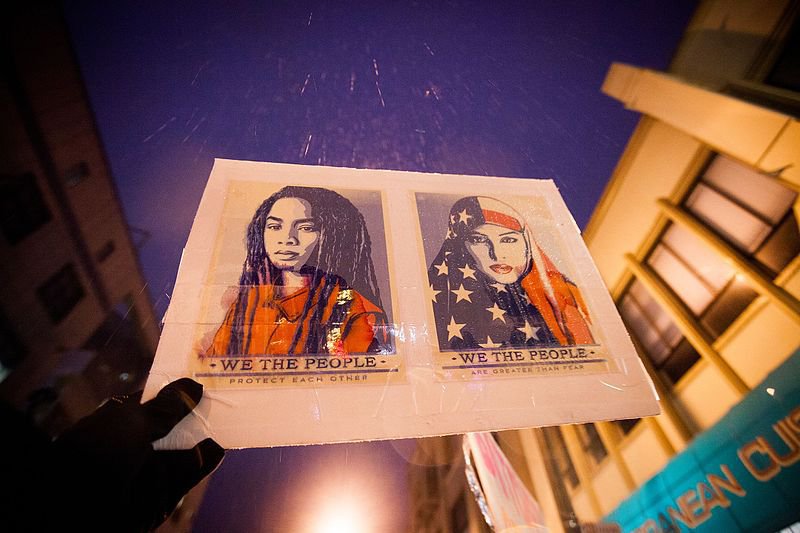Muslims in the Metropolis
Weekly Article

San Francisco Women's March
June 29, 2017
This past presidential election cycle was brutal for American Muslims. The tragic attacks in Paris, Brussels, San Bernardino, and Orlando provided plenty of material for some politicians, pundits, and media outlets to bet big and engage in all-out fear-mongering about Muslims. Chris Christie, for instance, said he wouldn’t allow even a 5-year-old Syrian refugee orphan into America—suggesting to the American public that there’s something so fundamentally dangerous about Muslims that even unaccompanied, vulnerable children should be denied entry to our country. President Donald Trump famously doubled down on his strident call for a “total and complete shutdown of Muslims entering the United States,” and for suspending the resettlement of all Syrian refugees, regardless of their age, gender, and need.
This barbed political rhetoric, coupled with Trump’s electoral victory, has coarsened public discussions about Muslim communities. It’s created fear and conspiratorial views that have emboldened some Americans to take matters into their own hands, as has been made clear by a sharp rise in hate crimes aimed at Muslims. And it’s had serious policy outcomes. Just this week, the Supreme Court announced that, in October, it would consider the legality of Trump’s travel ban, which has already been excoriated for its disproportionate impact on Muslim-majority countries.
It shouldn’t come as a surprise, then, that most Muslims feel that the current political season is significantly worse than at any time in memory. But is there a way to change this climate?
That’s exactly the question I’ve sought to investigate in my role as the director of New America’s Muslim Diaspora Initiative, in hopes of bettering our understanding of Muslim communities and pulling apart some of the myths that have, over the years, cropped up around Muslims. At the macro-level, we have an OK understanding of the 3.3 million American Muslims writ large—but at the local level, this understanding thins out.
And so to correct course, perhaps the questions to ask are these: What kind of impact do Muslims have on their neighbors and their neighborhoods? What role do they play in the civic life of their neighborhoods and cities? What effect do Muslim communities have on housing, schools, and health care? And to what degree—especially in this political environment—do Muslims feel a sense of belonging in wider society?
As I round out my first 90 days here, I’ve visited Muslim communities in Austin, Chicago, Houston, Las Vegas, the suburbs of Maryland and Virginia, southeast Michigan, New York City, and Peoria. And over the next year, I’ll continue to meet with and survey Muslim communities across the country. Doing so will, I anticipate, provide the best evidence to date of the many ways—big and small, obvious and subtle—that Muslims contribute to their local communities.
While there’s still much work to be done, here are two takeaways so far. First, it’s at the local level—in cities and neighborhoods—where things get done. Second, it’s not all negative. In fact, there are inspiring stories happening every day across the country—we just don’t hear them.
It’s at the local level where discrimination, harassment, and bullying take place, yes, but it’s also where communities and ordinary Americans come together to confront and address a range of challenges. In 2015, for example, when Illinois Governor Bruce Rauner wanted to suspend refugee resettlement in his state, the Syrian American community leaped into action. They worked hand-in-hand with other faith-based communities in Chicago, along with Mayor Rahm Emanuel’s office, to ensure refugee resettlement would continue and that refugees would feel welcome and be integrated. As a consequence of Governor Rauner’s anti-refugee policy proposal, the Syrian Community Network was created, and it now provides local services to refugees not only in Chicago, but also in Atlanta, Phoenix, and San Diego.
This sort of work doesn’t stop there, though. In Flint, Mich., the Muslim community has rallied and pooled resources to provide clean water and free medical services to those affected by the Flint water crisis. And long before the water crisis, the Muslim community in Flint had been engaged in other forms of community building. For example, they purchased a large, run-down building—the Broome Center—in one of the city’s most neglected neighborhoods and repurposed it as a neighborhood center to support underserved local youth, regardless of their faith.
In a time of remarkably polarized partisanship, it’s at the local level, it seems, where common ground and common purpose are being sought out. In Chicago, the Muslim community has helped organize “Iftar in the Synagogue”—an initiative to bring Iftar (breaking fast after sunset) into a few synagogues during Ramadan as a way to provide a safe space for interfaith prayer, dialogue, and understanding. Also in Chicago, Muslims started an initiative called Green Ramadan—a move to encourage Muslims to be more environmentally mindful—which has included campaigns for car-pooling and consuming less meat, as well as building the first solar mosque in America.
In examples like these, the common thread is that ordinary Americans are coming together to solve problems, restore trust, and help renew their communities.
All told, the answers to America’s most pressing problems most likely won’t be solved in Washington D.C., but rather through bottom-up community efforts. This is because communities are the level of society where people are moving beyond partisanship to solve problems. By examining these types of efforts, it’s possible to highlight innovations that may be portable and replicable in other parts of the country. But more than that, the hope is that this can also remedy the public record on common, and damaging, misconceptions about Muslim communities.